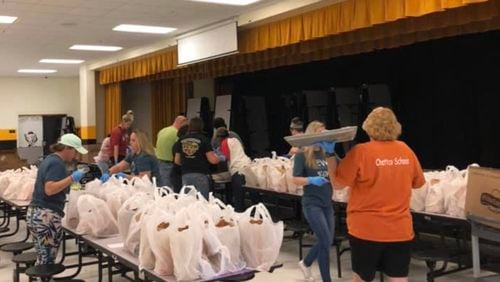As the coronavirus pandemic continues to hurt Georgia families struggling to make ends meet, a federal program designed to help the parents of school-age children pay for groceries will begin to roll out this month.
Officials with Georgia’s Division of Family and Children Services said the parents or guardians of a little more than 1 million of Georgia’s roughly 1.8 million k-12 students will begin to receive a one-time credit as early as this month through the federal Pandemic-Electronic Benefits Transfer program.
Federal guidelines estimate food costs at about $5.70 per child per day in school meal programs. Multiplying that by the 45 days students missed at the end of the school year means families will receive $256.50 per child.
Quanisha Jordan said the money helps but won’t go far.
The Atlanta resident said she doesn’t normally apply for food subsidies, except for the school breakfasts and lunches for her 9-year-old daughter.
But money is tight right now. The cafeteria worker at a local public school said her job is seasonal, so she’s not getting paid over the summer. She’s used to that. But her husband’s employer at a warehouse has cut his hours, which is something the couple wasn’t prepared for.
Jordan said she normally spends $125 to $150 a week on groceries for the three of them, but she’s noticed prices rising recently. The cost for hamburger where she shops has tripled, she said.
The P-EBT program is the result of the federal coronavirus stimulus package that passed in March.
It is meant to feed any child from a household with income low enough to qualify last spring for the free or reduced-price breakfasts and lunches at schools.
The income threshold for that program is generally higher than the threshold for the Supplemental Nutrition Assistance Program, commonly known as food stamps, through which the one-time payments are being channeled beginning this month.
So parents such as Jordan, who learned about the P-EBT money from a friend, will have to sign up with DFCS to get it even though they were already registered for low- or no-cost meals through their school. That program is expected to be online by the end of July.
It was difficult to ensure that everyone who was qualified to receive the P-EBT payment was able to register, said Jon Anderson, the chief deputy division director of DFCS’ Office of Family Independence. And some families who weren’t originally qualified for the school meal program are now, due to job loss or a reduction in work hours.
“We needed to make sure families get the right benefits and that we’re getting those benefits to the correct addresses,” Anderson said.
The roughly 300,000 families that already received SNAP benefits — and therefore already possessed an EBT card — will see the money credited directly to their accounts. Those who did not receive SNAP have to fill out an online form to match the information of the parent or guardian with the student to receive their card in the mail. DFCS expects about 515,000 families will receive the benefits.
After schools closed, children such as Jordan’s daughter still got two school meals a day, five days a week. But that is less than half the 21 meals a child should eat each week, said Linette Dodson, the nutrition director for the Georgia Department of Education, which worked with DFCS to get the state approved for the federal program.
It’s part of the effort to get food to kids during the pandemic. From the time schools closed in March to the beginning of summer break in May, about 170 of Georgia’s 180 school districts continued distributing meals to any child in the area, regardless of whether they attended public school or were from a low-income household — serving 28.6 million meals.
Many schools are continuing to distribute food this summer at over 1,000 sites, a little more than normal in what’s known as the annual U.S. Department of Agriculture-funded “seamless summer” program.
“It takes all of these resources to fill gaps families are experiencing,” Dodson said.
Kristie Brooks, the superintendent for the Chattahoochee County School District near Columbus, is so passionate about feeding kids that, using a school bus, she delivered meals herself after the schools shut down.
The district was among the few that couldn’t sustain a program over the summer, though. Normally, summer meals would be delivered through the local recreation department’s summer program. Without it, there’s no way to distribute food, Brooks said.
The $250 can fill that gap, she said.
“It’s beyond important,” Brooks said. “Things like that make a huge difference for some of our families.”
It still may not be enough, said Dodson, the Education Department’s nutrition director. “When you think of how far $5.70 goes at the grocery store,” she said, “that’s another challenge.”
The cards may also be difficult for some parents to use if they live in what’s known as a “food desert,” an area lacking grocery stores with produce and other healthy items, she added.
Food advocacy groups are pushing Congress to expand SNAP due to the hardship stemming from the confluence of a pandemic, a severe recession and rising food prices.
Jon West, the vice president of programs for the Atlanta Food Bank, said at a recent news conference that demand for free food is up 30% to 40% in the 29 counties his organization serves in and around metro Atlanta.
“Food banks cannot fill the gaps right now,” West said. “So from our perspective there’s no way to undersell the value of SNAP right now.”
In the meantime, Jordan is waiting for the assistance.
Since her family doesn’t receive SNAP, Jordan will have to apply for the school-related subsidy online once the application process is up and running.
“It will help,” she said, “but I can’t say it’ll help as much as needed.”









